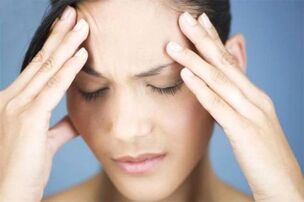Walking upright frees a person's hands to perform labor operations - this is definitely a plus. At the same time, the load on the spine has increased, which leads to the development of serious diseases, and this is a huge negative. Osteochondrosis is one of the most common pathologies of the spine. It affects 60% of the world's population over the age of 35. Surgery is one of the treatments, but an alternative is possible in the early stages of the disease. You can treat osteochondrosis at home. The range of effective therapeutic measures is wide and profitable.
What is osteochondrosis
Dysfunction and destruction of intervertebral discs and spinal tissues is a disease of the musculoskeletal system called osteochondrosis. Osteocytes are bone cells, chondrocytes are cartilage cells. Based on these names, the origin of the term "osteochondrosis" is clear. Degenerative-dystrophic changes in the spine have a negative impact on the general condition of the body.
As the disease progresses, muscle atrophy, nerve impulse transmission is disrupted, physiological systems and individual internal organs are destroyed. The appearance of pain in the back and neck is the first sign of the disease. Osteochondrosis depending on the location of the lesion focus:
- Main symptoms: pain in shoulders, arms, neck; dizziness, tinnitus, spots in front of the eyes.
- Characterized by dull pain or lumbago in the chest area.
- There is pain in the hip joints, back, sacrum. The functionality of the lower extremities is limited.
- It develops in several parts of the spine at once. Accompanied by severe pain.
With timely diagnosis, effective treatment of osteochondrosis at home is possible. Passes 4 degrees (or stages):
- The pathological process begins with dehydration of the central part of the intervertebral disc (nuclear pulposus). As a result, the structure is reduced, cracks appear on the outer part of the disc (annulus fibrosus). This stage is almost invisible to the patient. Mild anxiety manifests itself in an anxious posture or during active physical activity.
- Due to the collapse of the intervertebral disc, the distance between adjacent vertebrae is reduced. The garden and muscles shake. The vertebrae gain extra mobility. For this reason, IDPs. This condition is called spondylolisthesis. With a strong load, the patient feels discomfort, sometimes pain in the localization of the pathology.
- The formation of prolapses (hernias), disc protrusions (uneven protrusions), subluxations of the intervertebral joints and osteoarthritis are the main pathological changes in the third stage of the disease. The patient's movements are limited, numbness, tingling in the limbs. There is pain, the localization of which depends on the location of the center of the disease.
- In order to eliminate the excessive mobility of the vertebrae, the body forms neoplasms of bone tissue (osteophytes) in the spine. Their formation is chaotic, depending on the location, and can damage the spinal cord and nerve endings of adjacent vertebrae. The process of obvious structural changes (fibrous ankylosis) begins in the intervertebral joints. The vertebral-motor segment appears "walled". At this stage, the symptoms of osteochondrosis are practically not felt.
How to treat cervical osteochondrosis at home. How can first aid be provided at home?
Home treatment for cervical osteochondrosis includes:
- medicines;
- physiotherapy;
- massage;
- medical gymnastics;
- diet correction.
Therapies allow to achieve good results in the treatment of cervical osteochondrosis. Symptoms can be very disturbing, so you need to know how to give first aid.
Medications
Various medications are used to treat the symptoms of the disease. They should be prescribed by a doctor who specializes in the treatment of osteochondrosis - a neurologist or vertebrologist.
Medications

- For severe pain, you can take a painkiller such as metamizole sodium. If they do not work, NSAIDs may be accepted.
- Sometimes "distractions" are used, such as pepper patches. It does not heal on its own, but warms the inflamed area and relieves pain.
- Herbal infusions and diuretics are useful for edema in the area of inflammation.
The following groups of drugs are prescribed for the treatment of SHS:
- Non-steroidal anti-inflammatory drugs (Nimesulide, Ketoprofen, Meloxicam, Diclofenac and others). They help relieve pain, swelling and inflammation of the affected nerve root.
- B vitamins help improve metabolic processes in nerve tissues.
- Chondroprotectors. Promotes cartilage tissue regeneration
- Muscle relaxants (tizanidine, tolperisone hydrochloride). Helps reduce muscle spasms
- Drugs aimed at improving blood flow and rheological properties of blood. They help improve blood flow to the brain and the nutritional process of the affected nerve endings.
Intramuscular injections may also be indicated.
How to treat cervical and sternal osteochondrosis at home. An overview of home remedies
Osteochondrosis of the cervical and sternum causes disability if left untreated. Pathological symptoms:
- a slight tension in the affected area (neck, chest), pain with sudden movements;
- headaches;
- dizziness;
- shortness of breath and shortness of breath;
- fatigue.
If disturbing symptoms occur, you should consult a doctor for further diagnosis. If the diagnosis is confirmed, the doctor will determine the stage and prescribe treatment.
Treatment of thoracic and cervical osteochondrosis involves a conservative technique and operation. At home, you can engage in treatment in the first and second stages of development. Deterioration of the condition, further displacement of the vertebrae, fusion, the defect is eliminated during the operation.
Home treatment of thoracic and cervical osteochondrosis is carried out with the help of pharmaceutical drugs, a complex of light physical exercises, folk recipes for rubbing, compressors. Doctors recommend going to the pool, massage therapist, physiotherapy rooms. The measures are aimed at relieving the symptoms:
- muscle relaxation;
- stimulation for cartilage layer regeneration;
- return of displaced vertebrae to their previous position;
- Release of compressed nerve fibers.
Home treatment of cervical and thoracic osteochondrosis will be effective if all the doctor's recommendations are followed.
Pharmacy preparations
Cervical and thoracic osteochondrosis can be treated with home remedies - very common medications that are easy to buy in pharmacies. Do not take treatment without a doctor's prescription, a wrong treatment will delay the healing process. It is impossible to predict the body's response to drugs. Prevents pain in the affected area, eliminates muscle tone, increases blood circulation, improves metabolic processes and improves well-being.
Medications slow down progress.
Home remedies for the treatment of thoracic and cervical osteochondrosis in the chest and neck:
- Non-steroidal anti-inflammatory drugs help eliminate inflammation and edema at home. After the completed course, a decrease in pressure on the spinal arteries and blood vessels is observed in the spine.
- Painkillers quickly relieve pain and nervous tension.
- Sedatives - drugs that relax muscle tissue and relieve pain.
- Drugs based on chondroprotectors for osteochondrosis of the thoracic and cervical spine normalize metabolic processes in the cartilage and bone tissues of the spine. As a result, it is possible to stimulate the regenerative properties of tissues, increase the space between the vertebrae, and the deformed parts can take their desired place. Under the influence of chondroprotectors, pain is less pronounced.
- Vasodilator drugs that improve blood flow to the injured area. As a result of increased nutrition, the manifestation of symptoms decreases, the process of correction accelerates.
- Vitamins are a useful aid in the treatment of osteochondrosis at home. Group B, C, E intake provides the body with the substances it needs to fight. Stimulates the healing of cartilage tissue, strengthens the spine and improves the permeability of nerve fibers.
How to treat osteochondrosis and myositis at home. The main objectives of home treatment
If the patient has no serious disorders, moderate symptoms and no indications for hospitalization, the doctor decides to treat cervical osteochondrosis at home. The selected therapy tactics are aimed at eliminating the unpleasant manifestations of the pathological process and solving the following tasks:
- Normalization of blood circulation in the affected area.
- Elimination of cerebral hypoxia.
- Normalize sleep.
- Prevention of rapid disease progression.
- Blood circulation has improved.
- Initiation of regeneration processes to restore cartilage tissue.
- Saturation of the body with vitamins and minerals.
- Eliminate anxiety, panic attacks, irritability.
- Improve the condition of the cervical spine.
Treatment of chondrosis is completely impossible, but the right approach can significantly slow down the process, restore normal health and maintain a high quality of life for many years. This uses an integrated approach that includes dietary changes, increased physical activity, medication and a visit to a massage therapist.
Cervical osteochondrosis can be treated at home only with strict adherence to all the recommendations of the doctor, constant monitoring of nutrition and medication, and prescribed therapeutic exercises.
Cervical chondrosis is worth starting with pain relief. To do this, the specialist selects the appropriate painkillers. The pharmaceutical industry offers a variety of products that differ in the principle of operation, form and price. Novocaine blockade is possible with acute excruciating pain. Once the underlying symptomatology has subsided, alternative methods may be used. It can be:
- Massage procedures - relieve spasms, pain and tension.
- Sports therapy - strengthen muscle tissue, restore normal lumbar support and restore elasticity.
- Mud baths - warm the affected area and relieve pain syndrome for a long time.
- Manual therapy - restores metabolic processes and improves blood flow, eliminates oxygen starvation of the brain.
- Reflexology - reduces pain in the region, begins the process of renewal of cartilage tissue.
- Acupuncture - activates metabolism, improves the condition of cartilage tissue, reduces the appearance of painful sensations in the affected area.
The most convenient treatments at home are ointments, rubs, baths, decoctions, compresses. Such traditional medicines have been known for a long time and are known for their safety, ease of use and minimal contraindications.
How to treat cervical spine osteochondrosis at home. Symptoms of the disease
In the early stages, cervical lumbar osteochondrosis cannot be seen in any way. Accompanying symptoms appear only in the form of a pathology that develops when the blood circulation in the brain is disturbed. This process is generally accompanied by:
- dizziness;
- matching of limbs;
- with cold hands and feet;
- "goose feathers" in the eyes, dark;
- headaches;
- sound in the head, sound in the ears;
- increased fatigue;
- nervousness;
- lack of coordination;
- gait instability;
- Tingling, tingling in the neck muscles.

If the disease becomes chronic, anxiety and pain accompany the patient. Main manifestations:
- painful sensations in the back of the head, neck, shoulders, arms, difficulty moving the head, wheezing when turning or bending the head;
- pain in the left chest with radiation on the left side, burning sensation between the shoulder blades;
- frequent headaches, increased fatigue, weakness, difficulty turning head;
- neck pain extends to shoulder and arm, numbness in fingers;
- Hearing and vision disorders, numbness of the tongue and face, dizziness, and impaired lung and heart function may be seen.
Symptoms are divided into three groups:
- neurological manifestations (persistent pain in the neck, pain in muscles, chest, joints);
- pathological effects on the spinal cord (weakness in the arms and legs, involuntary twitching, myelopathy);
- related to processes occurring in the brain (cerebral manifestations due to insufficient blood supply: visual disturbances, foreign body sensation in the throat, sounds and ear sounds, hearing loss, dizziness, fatigue during walking, weakness, irritability, sleep disturbances, memory impairmentdecrease).





































